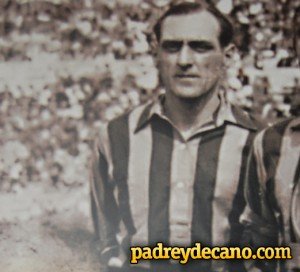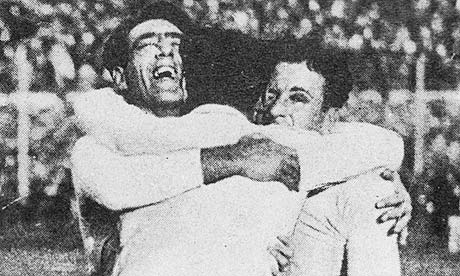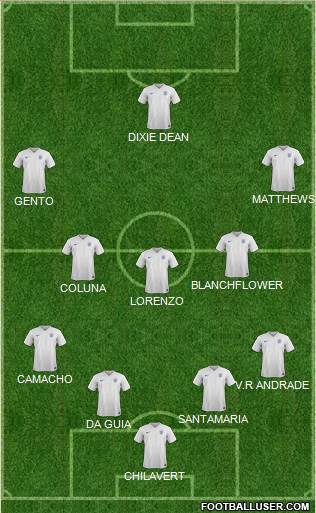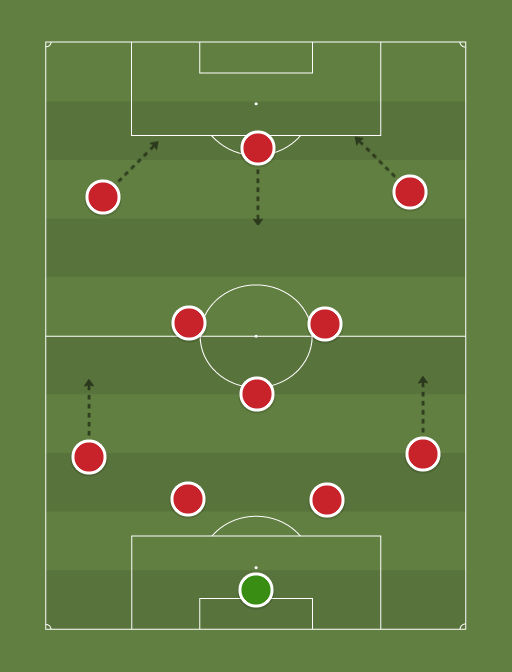Annahnomoss
Full Member
- Joined
- Oct 4, 2012
- Messages
- 10,101
TEAM STOBZILLA
Chilavert
V.R Andrade(by Anto)

Víctor was José Leandro Andrade's nephew. He idolised his uncle so much he insisted on being referred to using both his parents' surnames, otherwise he would have just been one of a million Rodríguez's. He played as a right halfback just like him, although he was stronger in defensive phases while somewhat less adventurous going forward. Not that he didn't do it, but he was far more defensively sound than anyone around so it was usually the case that if one of the two had to play a more conservative game he would be the one doing it.
That tactical discipline and submission to what the team needed was further demonstrated at the 1950 World Cup when, in the absence of good quality leftbacks and with a fair few good rightbacks around, it was Rodríguez Andrade who was deployed on the left with Juan Carlos González on the right and then Gambetta when he got injured against Spain.
Gambetta was a good rightback and, in fact, the one the dribble is named after in South America (gambeta). His classic runs piling up rivals are referred to as "gambetear" to this day. However, he had spent the first half of the tourno messing about and acting as the official team photographer (he was a character), which may have contributed to him having an absolute mare against Sweden. With Zizinho starting on his side and Zizinho-to-Ademir being a proven devastatingly effective route to goal, things looked ominous. So Uruguay surprised Brazil on the day by starting Rodríguez Andrade on the right and Gambetta on the left.
Within five minutes though, the entire issue was sorted. The first or second time Zizinho gets the ball Víctor puts in one of those skeleton-busting tackles which are honest but dare you to try what dishonesty could be like. Zizinho didn't want to, and was largely anonymous for most of the game. Ever since then it has been a tried and tested stratagem, culminating in 1986 when Batista forgot the honest part of it and got himself into the record books as the fastest sending off in WC history. To make it an even more spectacular fail, Gordon XXX wasn't someone who would stop playing as a result.
But I digress. As the game progressed it was increasingly clear that Gambetta was fully focused and having a good game, but being on the left was occasionally presenting him some challenges. Still, Brazil was looking far more dangerous on the left, while Víctor's talent was getting pissed away on the right... So they swapped back. The odd thing was Brazil then swapped Zizinho and Jair. It has never been clear whether it was to keep Andrade away from Jair or because as soon as they swapped Gambetta tried to make a point to Zizinho and actually slid through him (Zizinho had been injured earlier in the WC and keeping people away from injury was important given no subs at the time). Or it may be a coincidence, feck knows, Jair wasn't one to follow tactical instructions anyway. Once Brazil scored he was supposedly asked to drop deep and help out his teammates who were struggling to contain Ghiggia. Apparently the instruction "didn't reach him".
The one time Zizinho and Ademir managed to link-up well Brazil scored through Friaca. Some say the linesman had actually raised his flag but then hid it up his arse when the stadium exploded in celebrations. Varela certainly hadn't seen that, his entire argument with the ref and linesman was predicated on one basic fact: rapid as Friaca was, there was no way he could beat Andrade in a sprint thus had to have been offside. He actually remained convinced to his death that the argument was watertight.
In any case, the Ghiggia show had long started and was about to bear fruit.
Four years later, Rodríguez Andrade was one of the main stars in the side (which had by now got itself a leftback). I've never come across anyone who could unequivocally say one tourno was better than the other, lots of ifs and buts and largely "he was just amazing in both". One fact that adds to this is how the semifinal unravelled. Puskas watched it from the stands and concluded Rodríguez Andrade was the best he had ever seen in his position. Czibor had scored, yes, but he had done the best job on him he had ever seen. Unfortunately, late in the first half of ET Andrade suffers a muscle tear. That was the tipping point, for the remaining 15-20 minutes Czibor had the freedom of that flank and the Czibor-Kocsis highway reactivated. Within a few minutes Hungary doubled their goal tally and put paid to the game.
José Emilio Santamaría Iglesias
Da Guia
Chilavert
Busted. I thought nobody would watch the GK write-up. Goalkeepers are supposed to prevent goals, not score them. But no-one seemed to have told Jose Luis Chilavert.
The outspoken, and sometimes controversial, Paraguayan made a name for himself not just between the sticks but at the other end of the field as well. An imposing presence with a huge build and a matching personality, Chilavert captained his country at two World Cups and was one of the best shot-stoppers in the world. But he also mastered the art of taking penalties and free-kicks. Chilavert amazingly scored 62 goals during his career, and his record of eight in 74 internationals is impressive when you consider he hardly ever ventured out into open play.
The outspoken, and sometimes controversial, Paraguayan made a name for himself not just between the sticks but at the other end of the field as well. An imposing presence with a huge build and a matching personality, Chilavert captained his country at two World Cups and was one of the best shot-stoppers in the world. But he also mastered the art of taking penalties and free-kicks. Chilavert amazingly scored 62 goals during his career, and his record of eight in 74 internationals is impressive when you consider he hardly ever ventured out into open play.
V.R Andrade(by Anto)

Víctor was José Leandro Andrade's nephew. He idolised his uncle so much he insisted on being referred to using both his parents' surnames, otherwise he would have just been one of a million Rodríguez's. He played as a right halfback just like him, although he was stronger in defensive phases while somewhat less adventurous going forward. Not that he didn't do it, but he was far more defensively sound than anyone around so it was usually the case that if one of the two had to play a more conservative game he would be the one doing it.
That tactical discipline and submission to what the team needed was further demonstrated at the 1950 World Cup when, in the absence of good quality leftbacks and with a fair few good rightbacks around, it was Rodríguez Andrade who was deployed on the left with Juan Carlos González on the right and then Gambetta when he got injured against Spain.
Gambetta was a good rightback and, in fact, the one the dribble is named after in South America (gambeta). His classic runs piling up rivals are referred to as "gambetear" to this day. However, he had spent the first half of the tourno messing about and acting as the official team photographer (he was a character), which may have contributed to him having an absolute mare against Sweden. With Zizinho starting on his side and Zizinho-to-Ademir being a proven devastatingly effective route to goal, things looked ominous. So Uruguay surprised Brazil on the day by starting Rodríguez Andrade on the right and Gambetta on the left.
Within five minutes though, the entire issue was sorted. The first or second time Zizinho gets the ball Víctor puts in one of those skeleton-busting tackles which are honest but dare you to try what dishonesty could be like. Zizinho didn't want to, and was largely anonymous for most of the game. Ever since then it has been a tried and tested stratagem, culminating in 1986 when Batista forgot the honest part of it and got himself into the record books as the fastest sending off in WC history. To make it an even more spectacular fail, Gordon XXX wasn't someone who would stop playing as a result.
But I digress. As the game progressed it was increasingly clear that Gambetta was fully focused and having a good game, but being on the left was occasionally presenting him some challenges. Still, Brazil was looking far more dangerous on the left, while Víctor's talent was getting pissed away on the right... So they swapped back. The odd thing was Brazil then swapped Zizinho and Jair. It has never been clear whether it was to keep Andrade away from Jair or because as soon as they swapped Gambetta tried to make a point to Zizinho and actually slid through him (Zizinho had been injured earlier in the WC and keeping people away from injury was important given no subs at the time). Or it may be a coincidence, feck knows, Jair wasn't one to follow tactical instructions anyway. Once Brazil scored he was supposedly asked to drop deep and help out his teammates who were struggling to contain Ghiggia. Apparently the instruction "didn't reach him".
The one time Zizinho and Ademir managed to link-up well Brazil scored through Friaca. Some say the linesman had actually raised his flag but then hid it up his arse when the stadium exploded in celebrations. Varela certainly hadn't seen that, his entire argument with the ref and linesman was predicated on one basic fact: rapid as Friaca was, there was no way he could beat Andrade in a sprint thus had to have been offside. He actually remained convinced to his death that the argument was watertight.
In any case, the Ghiggia show had long started and was about to bear fruit.
Four years later, Rodríguez Andrade was one of the main stars in the side (which had by now got itself a leftback). I've never come across anyone who could unequivocally say one tourno was better than the other, lots of ifs and buts and largely "he was just amazing in both". One fact that adds to this is how the semifinal unravelled. Puskas watched it from the stands and concluded Rodríguez Andrade was the best he had ever seen in his position. Czibor had scored, yes, but he had done the best job on him he had ever seen. Unfortunately, late in the first half of ET Andrade suffers a muscle tear. That was the tipping point, for the remaining 15-20 minutes Czibor had the freedom of that flank and the Czibor-Kocsis highway reactivated. Within a few minutes Hungary doubled their goal tally and put paid to the game.
(born 31 July 1929) is an Spanish-Uruguayan former football player and coach. He is regarded by many as one of the all-time greatest central defenders. A strong, uncompromising player, he is one of the relatively few players to star for two national football teams.
Santamaría played in defence for Nacional de Montevideo and was first called up to play for the Uruguay national team for the 1950 World Cup in Brazil. He was selected to fill an inside-forward slot in the squad, but his club refused to let him join the squad on the grounds that he was a defender. Hence he missed Uruguay's second World Cup victory. Four years later though, he was an integral part of the Uruguay team at the World Cup finals in Switzerland. Convincing wins over Scotland, Czechoslovakia and England were followed by semi-final defeat by Hungary and a 3-1 loss to Austria in the third-place play off match.
Santamaría's performance in the World Cup had been enough to attract the attention of Real Madrid, to whom he transferred in 1957. Real were dominating European football at the time, and Santamaria won three consecutive European Cup titles and the World Club Cup
Santamaría played in defence for Nacional de Montevideo and was first called up to play for the Uruguay national team for the 1950 World Cup in Brazil. He was selected to fill an inside-forward slot in the squad, but his club refused to let him join the squad on the grounds that he was a defender. Hence he missed Uruguay's second World Cup victory. Four years later though, he was an integral part of the Uruguay team at the World Cup finals in Switzerland. Convincing wins over Scotland, Czechoslovakia and England were followed by semi-final defeat by Hungary and a 3-1 loss to Austria in the third-place play off match.
Santamaría's performance in the World Cup had been enough to attract the attention of Real Madrid, to whom he transferred in 1957. Real were dominating European football at the time, and Santamaria won three consecutive European Cup titles and the World Club Cup
Da Guia
Domingos Antônio da Guia nicknamed the "the Divine Master" was a Brazilian footballer. He is regarded as one of the greatest players in Flamengo and Corinthians history, as well as the all time best brazilian defender.
He quickly rose to fame as one of Bangu's key players (central defender) between 1929-1932. Despite the fact Bangu had a history of fielding black players (Francisco Carregal was the first in 1905) Domingos witnessed racism in football as he was growing up. Seeing the brutality that some of the black players received is believed to have inspired Domingos's extraordinary ability to dribble with the ball and avoid defenders, a trait which Brazilians would become famous for around the world.
I will offer a couple of fragments from Argentine publications which give an idea of how Da Guia is regarded in Argentina
Translated from Boca Juniors 100 year anniversary collection book.
'In 1935 the team adquired Domingos Da Guia, a defender who was a catalog of class. The Brazilian was a central marker of inmense category. Great with his timing, skillfull with the ball, and never resorting to violence, he had shined with the verdeamarelha - he later played at the 1938 World Cup - and he formed an impassable tandem with Valussi, who was more of a tough guy and a fighter. Da Guia became a champion with teams from three countries: Brazil, Argentina and Uruguay. The day he arrived to the port of Buenos Aires, a huge crowd was waiting for him. The Ebony statue, as he was known in Brazil, descended from the boat in an impecable suit of white linen, and he put all of us in his pocket forever.'
Here are some other commentaries profiling the attributes of Da Guia:
'He is considered the best Brazilian defender of all time, and the first to take risks and innovate his position. The way he played led a revolution in football, since the ball didn't 'burn' Domingos. He liked to keep it next to his foot, and he never punted it away, which is what most defenders at the time habitually did. Watching him was true entertainment, and if that isn't enough, he was also solid and consistent in his marking.'
He quickly rose to fame as one of Bangu's key players (central defender) between 1929-1932. Despite the fact Bangu had a history of fielding black players (Francisco Carregal was the first in 1905) Domingos witnessed racism in football as he was growing up. Seeing the brutality that some of the black players received is believed to have inspired Domingos's extraordinary ability to dribble with the ball and avoid defenders, a trait which Brazilians would become famous for around the world.
I will offer a couple of fragments from Argentine publications which give an idea of how Da Guia is regarded in Argentina
Translated from Boca Juniors 100 year anniversary collection book.
'In 1935 the team adquired Domingos Da Guia, a defender who was a catalog of class. The Brazilian was a central marker of inmense category. Great with his timing, skillfull with the ball, and never resorting to violence, he had shined with the verdeamarelha - he later played at the 1938 World Cup - and he formed an impassable tandem with Valussi, who was more of a tough guy and a fighter. Da Guia became a champion with teams from three countries: Brazil, Argentina and Uruguay. The day he arrived to the port of Buenos Aires, a huge crowd was waiting for him. The Ebony statue, as he was known in Brazil, descended from the boat in an impecable suit of white linen, and he put all of us in his pocket forever.'
Here are some other commentaries profiling the attributes of Da Guia:
'He is considered the best Brazilian defender of all time, and the first to take risks and innovate his position. The way he played led a revolution in football, since the ball didn't 'burn' Domingos. He liked to keep it next to his foot, and he never punted it away, which is what most defenders at the time habitually did. Watching him was true entertainment, and if that isn't enough, he was also solid and consistent in his marking.'




 ) was: "Football players... We build them up to be superhumans above us mere mortals, it gets to their head, and they forget how vulnerable they are to the fickle nature of fans and the greater political nous of their masters. Here lies Lorenzo Fernández, his reputation in tatters for displaying the same pig-headedness that always served him so well in a different arena". Some things never change.
) was: "Football players... We build them up to be superhumans above us mere mortals, it gets to their head, and they forget how vulnerable they are to the fickle nature of fans and the greater political nous of their masters. Here lies Lorenzo Fernández, his reputation in tatters for displaying the same pig-headedness that always served him so well in a different arena". Some things never change.
